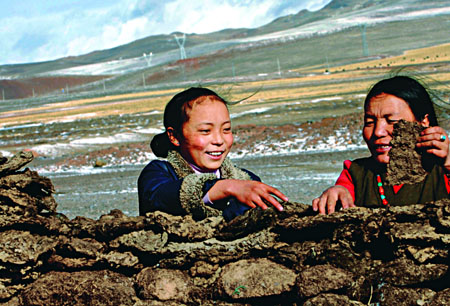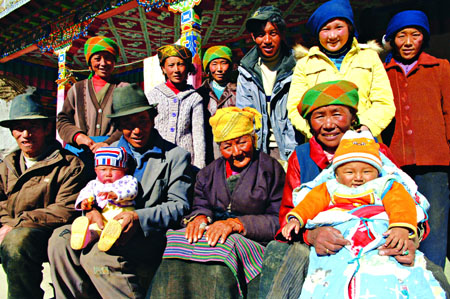| Tibet has basically established a social security system linking social insurance, social assistance, social welfare and social charity. On July 20, 2006, the People's Government of the Tibet Autonomous Region introduced the Plan for the Implementation Concerning Improvement of the Endowment Insurance System for Workers and Staff of Enterprises. This plan incorporated individual participation, namely, self-employed people and people without fixed employment in urban areas, and personnel engaged by State organs, institutions or people's organizations, into unified basic endowment insurance. In addition, pilot reform of basic medical insurance for urban employees was carried out in an all-round way, unemployment insurance system operated well, and industrial injury insurance system for enterprise employees grew steadily. In 2006, Tibet formulated the Childbearing Insurance System, which officially came into force in 2007. According to statistics, at the end of 2006, the number of workers and staff participating in the basic pension insurance had reached 44,500, of which 31,400 had received old-age pensions. The number of people participating in unemployment insurance and basic medical insurance totaled 72,000 and 164,900 respectively.

A girl is preparing cow dungs for her mother. In the Tibetan livestock breeding area, cow dungs are traditional fuel.
Employment
By the end of 2006, there were 1.4228 million employees in Tibet, a decrease of 12,200 from the end of 2005. Of them, 381,200 were in urban areas, an increase of 33,400. The registered urban unemployment rate was 4.3 percent.
In 2006, the Central Government and the people's government of the Tibet Autonomous Region allocated 33 million Yuan for employment and re-employment. At the same time, Tibet expedited the issuance of small loan by establishing sponsoring institutions. It encouraged the unemployed and college and technical secondary school graduates, to find their own jobs or establish businesses. At present, the whole region has formed a series of financing systems, such as tax reduction, petty loans, social insurance allowance, financial support, employment services and professional training and introduction supervised by the public. In the year, 17,400 jobless people found work.
Social Assistance
From 1997, Tibet started to establish the minimum living standard security system for urban residents. It first conducted pilot schemes in central Lhasa and then introduced the system in another six prefectures in 1998; by 2000, the program covered the whole region. Poverty-stricken urban residents, in line with their requirements, were incorporated into the scope of scheme. The security standard, 130 Yuan per person each month in 1997, has now been raised to 230 Yuan. In 2006, a total of 56.45 million subsistence allowances were issued.

The old man (third right, front row) is some 100 years old and has 120 children and grandchildren. Picture shows the old and her children and grandchildren.
In addition, Tibet also incorporated poor people in rural areas, those with low income and the vulnerable group whose annual per capita average net income was below 500 Yuan, into the scope of scheme of poverty-stricken people needing living assistance. Following an investigation of the family's income, the allowance is granted at a level that will enable them to reach the minimum living standard. In giving assistance, the principle is "guaranteeing in different types" to distinguish the elderly, minors and the handicapped who have no labor capability and have no other means of support. In 2006, Tibet allocated assistance totaling 37 million Yuan, helping 198,300 people. Starting from January 1, 2007, Tibet carried out the minimum living standard security system in farming and pasturing areas in an all-round way. It incorporated all the poverty-stricken farmers and herders whose per capita average net income was below 800 Yuan into the scope of the minimum living standard security and planned to allocate 46 million Yuan for this purpose, benefiting 230,000 poverty-stricken people.
For a long time, Tibet has held that rural households enjoying the five guarantees (childless and infirm old persons who are guaranteed food, clothing, medical care, housing and burial expenses) should be supported with a combination in concentrated and diverse forms, with priority given to the latter. The needed support funds come from central finance, while their needed living necessities such as grain ration and fuel are raised from the public. In 2003, Tibet raised the support standard given to the rural household enjoying the five guarantees from 588 Yuan to 900 Yuan per person. In 2004 and 2005, it rose to 1,200 Yuan and then 1,300 Yuan respectively, finally increasing to 1,500 Yuan in 2007, which is higher than the national average in this regard. Through the adjustments, the living standard of the household enjoying the five guarantees in the farming and pasturing areas of Tibet has markedly improved, and their rights and interests to basic living have been guaranteed. By the end of 2006, there were 8,663 households enjoying the five guarantees in Tibet. After the support fee standard was raised, the financial capital for supporting households enjoying the five guarantees each year has reached 12.9945 million Yuan.
At the same time, Tibet has also made great efforts to develop the social charity cause. In 2006, it allocated a total of 7.65 million Yuan to newly build nine bed-houses in rural areas and five welfare institutions. At the end of 2006, there were 1,899 people taken in by welfare institutions with 3,491 beds.
In 2006, the sale of 76 million Yuan worth of welfare lotteries raised 26.6 million Yuan in social welfare funds. Direct social donations totaled 15.2 million Yuan. |





